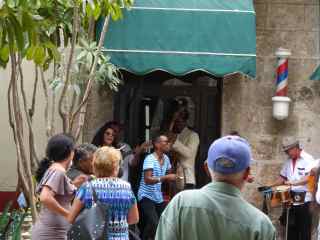After lunch, we toured Habana Vieja (Old Havana). From O'Reilly 304, it was a 5-minute walk to Plaza de Armas, the core of Habana Vieja.
Plaza de Armas is the oldest of Habana Vieja's squares and is located on the eastern edge of Habana Vieja. It's a patch of green with benches to rest and people watch or enjoy the live music from a nearby restaurant.
Live music from nearby restaurant.
The square is lined on 3 sides with brick pavers and on one side with wood. It's the only remaining street in Habana Vieja made of wood.
The center of the square is dominated by a marble statue of Carlos Manuel de Cespedes, a Cuban planter who freed his slaves, starting the Ten Years' War declaring Cuban Independence from Spain.
On the northeastern corner of Plaza de Armas is El Templete, a scaled-down version of the Parthenon and the site of the city's first Mass in 1519. Although Cuba's largest religion is Roman Catholicism, Christmas was not celebrated as a public holiday for 30 years between 1969 and 1998. Fidel Castro needed everyone to work on the sugar harvest on Christmas.
Unfortunately, the remaining Ceiba tree that was planted when the building was inaugurated in 1828 recently fell down.
Going clockwise from El Templete is the Museo Nacional de Historia Natural (the Natural History Museum). It used to be the US Embassy in the 1930s. In front of the museum, you'll see people on their smart phones. It's one of the few places in town where there is wifi. Purchase a card with a code that gives you access to wifi for 6 CUCs/hour. It's slow download speed and not worth it.
Cell phones are not widespread. There are still pay phones--yes, they do exist.
Next up is the Museo de la Ciudad on the western edge of Plaza de Armas. This security guard, cigar in mouth, insisted on posing for a picture. Surprisingly, he wasn't looking for a tip. The Museo occupies the Palacio de los Capitanes Generales, the seat of the Spanish government from 1791 to the end of the Spanish-American War in 1898.
On the northern edge of the Plaza is the Palacio del Segundo Cabo. It was the residence of the 2nd highest ranking official in Cuba. It has been undergoing a Unesco renovation and should open as a Center for the Interpretation of Cultural Relations between Cuba and Europe.
Next to the Palacio del Segundo Cabo is the Castillo de la Real Fuerza, the oldest surviving fortress in Cuba. It's surrounded by a moat. It's 3 CUCs to enter and there is an exhibit of Cuban naval history. Unless you're a big model ship fan, it wasn't worth the cost of admission.
2017 03 05











No comments:
Post a Comment